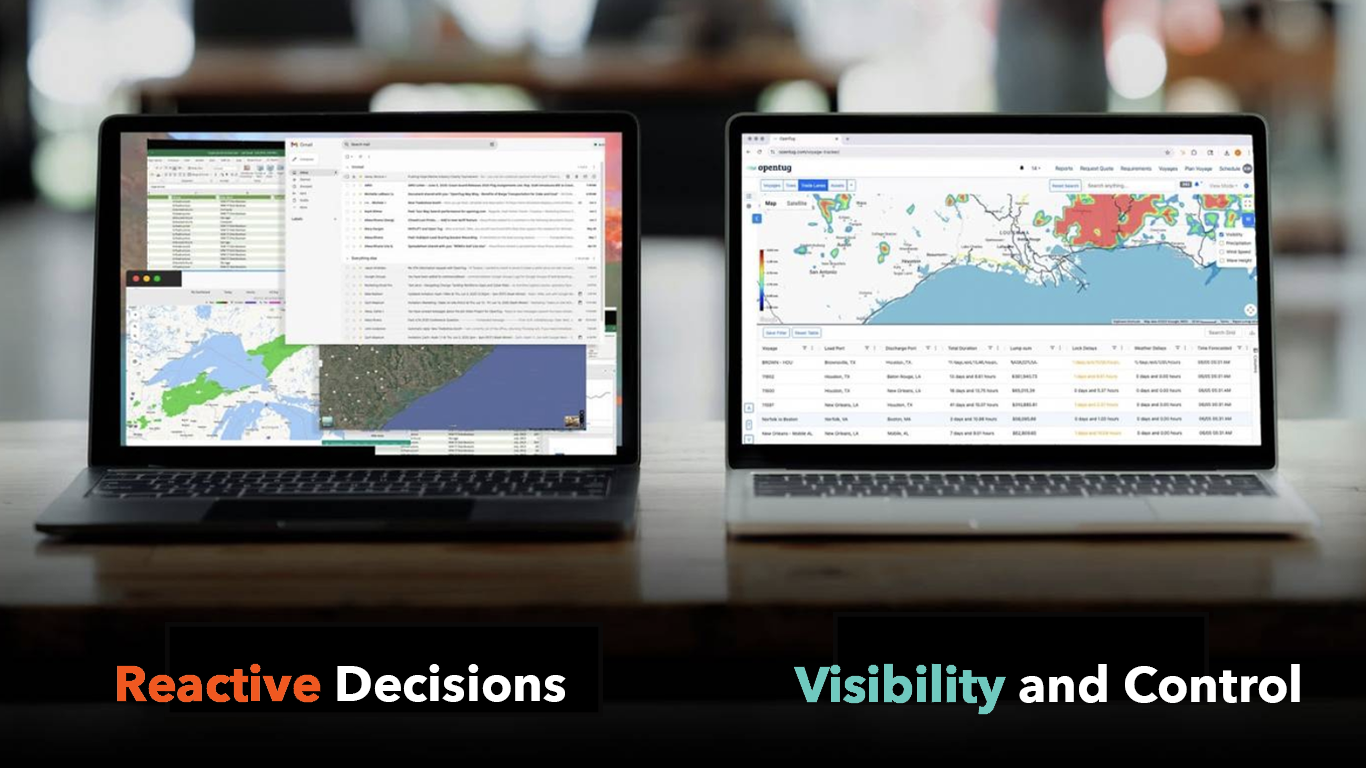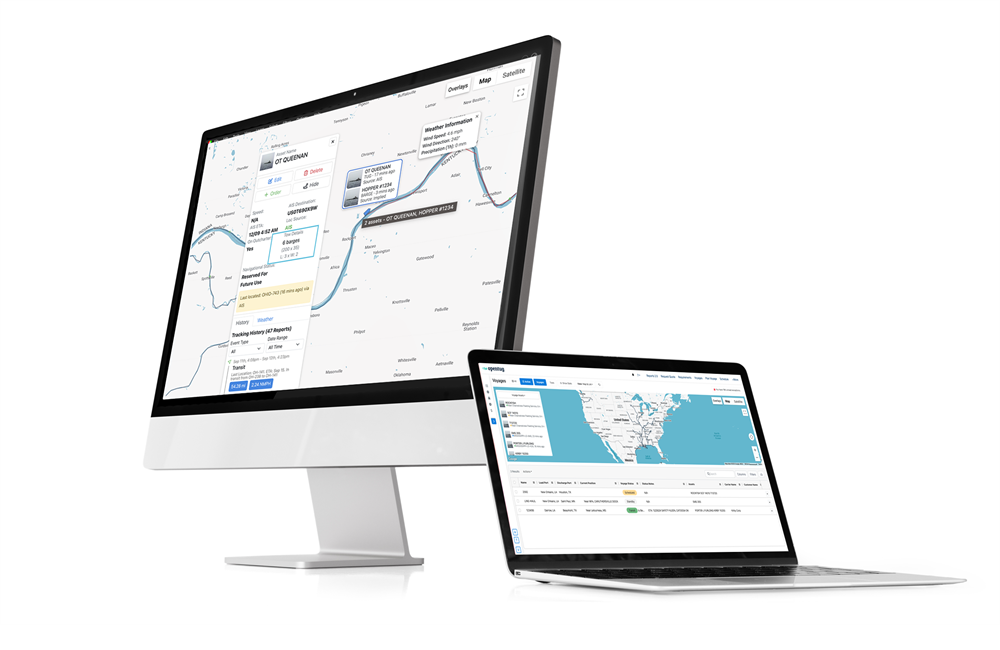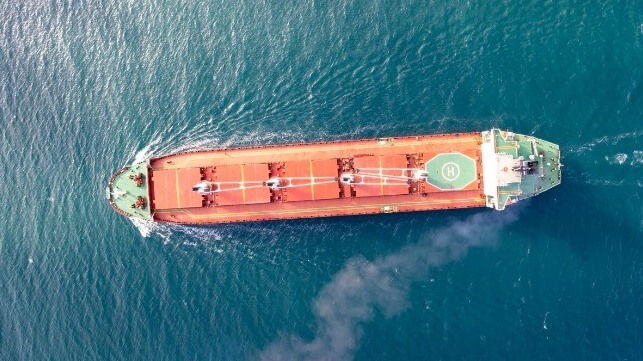Real-Time Visibility Transforms Barge Operations
The inland barge industry stands at a critical juncture. While we’ve long known that barges move cargo more efficiently than trucks or rail—past studies have shown 647 ton-miles per gallon compared to rail’s 477 and trucking’s 145—our operational visibility has lagged behind other transportation modes. This disconnect between our mode’s advantages and technological capabilities has cost operators millions while the larger conversation around supply chain digitization has only intensified. Ocean carriers and trucking companies alike have embraced real-time tracking as table stakes. Shippers increasingly expect the same level of visibility from their barge operators. Those who can’t provide it risk losing customers to modes that can, regardless of cost or environmental impact.
The Hidden Cost of Operational Blind Spots
Operational efficiency challenges in inland maritime are intensified by increasingly volatile conditions. Weather conditions, variables locking time, and river levels can all introduce significant delays and financial consequences to voyages, while rate volatility adds another layer of complexity. For example, look at the impact of recent weather-related disruptions on the Mississippi River. In 2022, a backup of more than 2000 barges was reported due to low water levels. In 2023, record-low levels returned for the second year in a row and weather fluctuations again significantly impacted barge rates for major commodities. Looking at these dramatic fluctuations, it is easy to see how many operators struggle to predict revenue and optimize their operations without access to real-time data.
Consider a typical scenario: a barge carrying agricultural commodities approaches a grain terminal without advance notice of its precise arrival time. The terminal, unable to predict the exact timing, schedules conservatively, resulting in a scramble for a berth or adequate labor. The result? Even small delays can lead to demurrage charges or have downstream impacts on scheduled services such as cleaning and maintenance for the operator. With real-time visibility, terminals can optimize berth assignments and labor scheduling while carriers avoid costly delays and better coordinate their fleet operations—a win-win that reduces costs and improves service reliability for all parties.

BargeOS: Transforming Operations Through Intelligence
BargeOS addresses these challenges by providing real-time intelligence across tracking, 3rd party data integration, and AI-driven predictive analytics to transform how barge operators manage their fleets.
Visibility goes beyond traditional AIS with satellite-connected GPS tracking devices for maximum coverage, while BargeOS Autopilot introduces a breakthrough way to enable precise tracking without installing hardware. By ingesting email nominations and traffic updates, BargeOS Autopilot converts unstructured communications into structured voyage data inputted directly into the dashboard giving operators full visibility into fleet movements. This means stakeholders can instantly monitor barge positions and status,eliminating hours of manual entry and providing a reliable single source of truth.
BargeOS also simplifies voyage planning and quoting processes. By analyzing historical voyage data, real-time lock conditions, water levels, weather, and other external factors, the tool leverages powerful AI to predict potential disruptions and suggest optimal routing. Operators can proactively adjust schedules and resources to reduce idle time, optimize throughput, and better serve customers leading to efficiency gains across the supply chain.
Revenue Optimization Through Asset Intelligence
The financial impact of improved visibility extends well beyond customer satisfaction. Faster turnaround times directly increase asset utilization. For a typical barge operator, even small improvements in efficiency could translate to additional voyages, with each additional voyage representing increased revenue.
The platform also enables operators to optimize voyage planning through historical performance data. By analyzing patterns in transit times, weather impacts, and terminal efficiency, operators can continue to make more informed decisions about routing, scheduling, and capacity allocation.

Building Customer Trust Through Transparency
In today’s competitive transportation market, trust has become a differentiating factor. Customers increasingly value transparency and reliability over purely cost-based considerations. BargeOS enables operators to more effectively support those long-term customer partnerships. For example, the platform allows carriers to give customers access to monitor their shipments in real-time, and receive automated status updates. This transparency reduces the amount of direct communication required between shipper and carrier while simultaneously improving customer confidence in service reliability.
When customers can see exactly where their cargo is and when it will arrive, they’re more likely to choose barge transportation for future shipments. This customer loyalty translates directly into revenue stability and growth opportunities.
Competitive Advantage in Digital Supply Chains
Customer system integration plays a critical role in digital supply chains. BargeOS provides APIs that allow customers to incorporate barge tracking data directly into their own logistics management systems. The platform offers a single source of truth for all documents, allowing for faster auditing and payment of invoices. With enhanced back office processing and new integration capabilities, operators are positioned as sophisticated supply chain partners rather than simply transportation providers.
Data analytics capabilities also help operators identify new business opportunities for growth. By analyzing cargo flows and customer patterns, operators can identify opportunities for improved lane efficiency, discover new potential market segments or optimize their service offerings to meet emerging demand. With financial performance analysis, operators can easily monitor costs, see revenue per voyage, track demurrage and better understand asset and portfolio utilization.
Implementation and ROI
Deploying BargeOS requires minimal disruption. The platform’s hardware can be installed quickly on existing vessels, and the cloud-based software requires no on-site IT infrastructure. Most operators achieve full functionality within weeks and ROI typically manifests within the first year through improved asset utilization and reduced operational costs. Enhanced customer satisfaction and retention provide additional long-term value for the business.
The Future of Barge Operations
As we look toward the future, operational intelligence will become increasingly critical to success. The operators who embrace these technologies today will be best positioned to capitalize on the growing demand for efficient, sustainable freight transportation.
BargeOS transforms how operators manage their assets, serve their customers, and compete in the modern logistics landscape. For operators ready to maximize their potential, a comprehensive solution is available today.
Jason Aristides is CEO of OpenTug, the technology company behind BargeOS. For more information about BargeOS, visit OpenTug.com.




